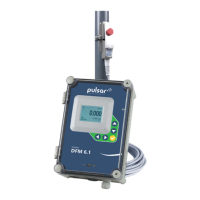PULSAR MEASUREMENT
33
COMMON QUESTIONS AND ANSWERS
The pipe vibrates. Will it affect the flow meter?
Common vibration frequencies are far lower than the sonic frequencies used by the flow meter and will not
normally affect accuracy or performance. However, applications where very weak Doppler signal is present (when
sensitivity is adjusted to maximum and signal strength is low), accuracy may be affected by pipe vibration, or the
flow meter may show readings under no-flow conditions. Attempt to relocate the sensor on a pipe section where
vibration is reduced, or arrange pipe mounting brackets to reduce vibration at the sensor mounting location.
The flow meter must be installed in a high noise environment. Will this affect operation?
Our flow meters are designed to discriminate between environmental noise and the Doppler signal. High noise
environments may affect the flow meter’s performance where low signal strength and/or low flow velocities are
being measured.
Will pipe corrosion affect accuracy of the flow meter?
Yes. Rust, loose paint etc. must be removed from the outside of the pipe to provide a clean mounting position
when installing a Doppler sensor. Severe corrosion/oxidation on the inside of the pipe may prevent the Doppler
signal from penetrating into the flow. If the pipe cannot be cleaned, a spool piece (PVC recommended) should be
installed for sensor mounting.
What effect do pipe liners have on the flow meter?
The air gap between loose insertion liners and the pipe wall prevent the Doppler signal from entering the flow.
Better results can be expected with bonded liners such as cement, epoxy or tar, however an on site test is
recommended to determine if the application is suitable for a Doppler flow meter.
Why is Doppler only recommended for liquids containing suspended solids or gases?
The Doppler sensor transmits sound into the flow stream which must be reflected back to the sensor to indicate
flow velocity. Gas bubbles or suspended solids act as reflectors for the Doppler signal. As a guideline, our Doppler
flow meters are recommended for liquids containing solids or bubbles with a minimum size of 100 microns and a
minimum concentration of 75 ppm. Most applications (except potable, distilled or deionized water) will meet this
minimum requirement.
Can the sensor be submerged in water?
Yes, for short periods of time or by accident, but it is not recommended for continuous operation. The sensor is
constructed to withstand submersion to 10 psi without damage, but external liquid moving in contact with the
sensor can be interpreted as flow and cause false readings.
What is the purpose of the Signal Strength Display?
Doppler signals of very low strength are not accepted or processed by the instrument. This feature assists in
rejection of environmental noise and vibration. Use the display to evaluate signal strength in your application.
Strong signals will increase in percentage to a maximum of 100% or greater.
Can I change the length of the sensor cable?

